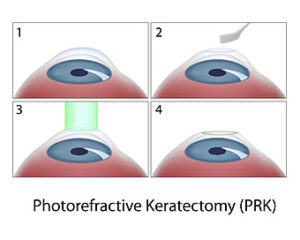When most people think about vision correction surgery, LASIK is the first thing that comes to mind. While LASIK is an excellent procedure and very popular, it isn’t for everyone.
You can only have LASIK if you qualify as a candidate for it. It also isn’t the only vision correction surgery you can have.
There are alternative procedures that are very similar to LASIK. One of the most similar vision correction procedures is PRK.
PRK is often a good choice if you find out you don’t qualify for LASIK. Both procedures are laser surgeries with similar outcomes, but they have a key difference. Keep reading to learn more about PRK and if it could be the right vision correction procedure for you!
Refractive Laser Eye Surgery
Laser vision correction surgery focuses on changing the shape of the cornea. The cornea is the clear, front part of your eye that light passes through.
When light passes through the cornea, it refracts, bending before hitting your retina. When you have a refractive error like nearsightedness, farsightedness, or astigmatism, your cornea has irregularities that change how light refracts.
Having a cornea with irregularities causes your vision to appear blurry if you’re looking at something too close, too far, or in the case of astigmatism, at any distance.
How Refractive Laser Eye Procedures Work

The goal of laser vision correction surgery, more commonly known as refractive laser eye procedures, is to correct these irregularities in the shape of the cornea by removing corneal tissue with a special kind of laser called an excimer laser. The excimer laser removes a tiny amount of tissue, reshaping the cornea to correct your refractive errors.
After removing tissue with an excimer laser, it doesn’t grow back, making refractive surgery permanent. Your vision may get worse as you get older due to age-related conditions.
Undergoing a laser vision correction procedure won’t mean you won’t develop presbyopia or cataracts when you’re older. These are inevitable parts of the aging process that everyone experiences.
As long as your prescription is stable when you have your vision corrected, you can look forward to decades of clear vision after your vision correction procedure.
LASIK
LASIK is the most well-known refractive laser eye surgery. It’s highly effective and very low-risk.
These are part of why LASIK is the most popular elective procedure you can undergo. Before treating the cornea with an excimer laser, your LASIK surgeon will use a femtosecond laser to make a flap in the cornea.
The laser creates this flap out of the very top of the cornea. It leaves only a part of the flap connected to the rest of the cornea. The flap gets replaced once LASIK is over. The area of corneal tissue under the flap is then sculpted with the excimer laser.

After replacing the flap, it acts as a natural bandage as your eyes heal during the LASIK recovery process. You don’t need to worry about stitches or sutures as it naturally stays in place while it fuses back with the rest of your eye.
But to safely make a corneal flap, you need to have a cornea that’s thick enough. If your cornea is too thin, creating a flap could leave too little tissue in your corneal bed, causing extreme visual aberrations.
These visual aberrations could make it unsafe to undergo LASIK. For this reason, only patients with corneas of a certain thickness qualify for LASIK. Corneal thickness is one of the most critical factors for LASIK candidacy.
Most people who have a LASIK consultation will end up being good candidates. But between 10% and 15% of patients are screened out, often due to corneal thickness. Luckily, an alternative refractive laser eye surgery exists that doesn’t require creating any kind of corneal flap.
PRK

Although LASIK is the most popular elective procedure you can have, it was not the first laser vision correction procedure available. That distinction belongs to PRK.
PRK predates LASIK as the first refractive laser eye surgery. It’s still performed today with the latest technology and is an excellent alternative to LASIK.
Many people who do not qualify for LASIK get PRK instead because it doesn’t require a corneal flap. Instead, the outer layer of the eye, called the epithelium, is scrubbed off before the excimer laser reshapes the cornea. While the epithelium grows back, special contact lenses act as bandages to protect your eyes.
LASIK and PRK produce comparable results, with high satisfaction rates and most patients achieving 20/20 vision or better. But the main difference between the procedures is in recovery.
Surgery and Recovery After PRK

After getting LASIK, most patients see an immediate improvement in their vision. While initial recovery from LASIK only takes a few weeks, the flap doesn’t fully heal until a few months after correcting your vision.
But as your eyes heal, your vision only improves until you achieve your best vision once they’ve finished healing. It can take six months to a year to reach your peak vision and have your eyes completely stabilize after LASIK.
Recovery time for PRK is comparable. Although you will notice an improvement to your vision after PRK, it may not be as immediate as after LASIK.
It may take a few days before you start noticing more visible improvements. The recovery period after PRK is not as fast as LASIK, and you may experience some discomfort as the epithelium grows back. Your eyes will still take several months to finish healing. Over that time, your eyesight will steadily improve until you reach your best vision, just as with LASIK.
Although LASIK is the newer and preferable procedure for most patients, PRK is perfect for those who don’t qualify for LASIK due to corneal thickness. There’s no reason not being a LASIK candidate should hold you back from the vision you want!
Schedule an appointment at South Texas Eye Institute in San Antonio, TX, to learn more about laser vision correction procedures and if PRK could be right for you!

